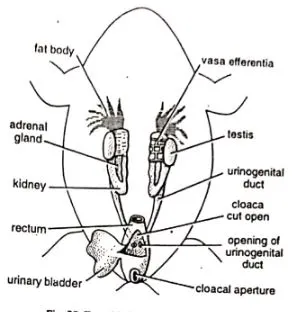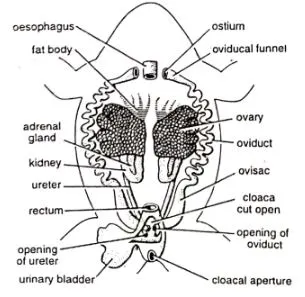Urinogenital System of Frog | Diagram

In this article about the frog, we will discuss the urinogenital system of frog (Hoplobatrachus tigerinus or Rana tigrina).
What is Urinogenital System?
The urinogenital system is the combination of the excretory system and the reproductive system. Though both systems are completely different but in male frogs’, urinary products and reproductive/genital products pass out through common urinogenital ducts. So the systems are generally described together.
Diagram

Fig : Male urinogenital system of frog.

Fig: Female urinogenital system of frog.
Excretory System of Frog
- It is a physiological process by which the animals expel their nitrogenous wastes from the body.
- It is similar in both males and females.
- This system includes a pair of kidneys, a pair of ureters, a urinary bladder, and a cloaca.
1. Kidney
-
-
- A pair of kidneys are present.
- They lie posteriorly, outside the abdominal coelom, and attached to the vertebral column.
- On their ventral surfaces, they are covered with peritoneum.
- The kidneys are mesonephric.
- Anteriorly, each kidney has several small fat bodies and a testis or ovary.
-
2. Ureter
-
-
- The ureter is a tube that arises from the posterior outer margin of each kidney.
- It extends backward to open into the cloaca.
- In male frogs, ureters pass both the urinary and genital products (sperms) and that’s why it is called the urinogenital duct for the male frog only.
-
3. Urinary Bladder
-
-
- The ureters open into the urinary bladder.
- It is a thin-walled, transparent, and bilobed sac.
- The urine is stored here temporarily.
-
4. Cloaca
-
-
- It is a small chamber.
- The anus, urino-genital apertures and urinary bladder opens here.
- The cloaca opens outside by a sphinctered cloacal aperture.
- It is present between the bases of the two hindlimbs.
-
Physiology of Excretion
- Frog excretes urea along with water.
- Due to ultrafiltration of blood in the glomerulus, excessive water with nitrogenous wastes is filtered out into the Bowman’s capsule.
- Then the useful substances are reabsorbed into the blood.
- The remaining fluid forming urine is carried by the ureters and is temporarily stored in the urinary bladder.
- Then the urine eliminated through the cloacal aperture.
Male Reproductive System of frog
- The male reproductive system of frog consists of two testis, vasa efferentia and two urinogenital ducts.
- Copulatory organs are absent.
1. Testis
-
-
- It is an elongated body attached to the kidney at the antero-ventral region.
- It is attached to the kidney by mesorchium.
- Mesorchium is a double fold of peritoneum.
- Fat bodies are present near the anterior end of the testis which provide food to the developing spermatozoa.
- Each testis is a compact mass of much coiled seminiferous tubules.
- Sperms of the frog are produced in the testis by the process of spermatogenesis.
-
2. Vasa Efferentia
-
-
- All the seminiferous tubules unite to form 10-12 vasa efferentia.
- These are the narrow tubes.
- It connects the testis to the ureters.
-
3. Urinogenital Duct
-
-
- Ureters in male frogs carry both urinary products and genital products.
- Ureters are the urinogenital ducts for male frogs.
- The urinogenital ducts form seminal vesicles which are the temporary storage for the spermatozoa.
- Urinogenital ducts open to the cloaca.
-
Female Reproductive System of frog
- The female reproductive system of frog consists of two ovaries and two oviducts.
1. Ovaries
-
-
- Two ovaries are present.
- Each ovary is attached to the dorsal abdominal wall near the kidney.
- The attachment of the ovaries to the dorsal abdominal wall is supported by the mesovarium.
- The mesovarium is a peritoneal fold.
- The ovaries become greatly enlarged during the breeding season.
- Ova are produced inside the ovaries by the process of oogenesis.
-
2. Oviducts
-
-
- Two oviducts are present.
- They are long and much-coiled tubes.
- They are not connected to the ovaries directly.
- The anterior end of the oviduct is a funnel-like opening called ostia.
- The posterior end of the oviduct opens into the cloaca.
- Before opening into the cloaca, each oviduct forms a sac-like ovisac.
- The eggs are collected inside the ovisacs before being laid.
-
—————–THE END——————
Read More:
- Nervous System and Sense Organs of Frog | Diagram
- Blood Circulatory System of Frog | Diagram
- Respiratory System of Frog | Diagram
- External Morphology of Frog | Diagram
- Digestive system of Frog with Diagram
- Hoplobatrachus tigerinus (Previously Rana tigrina) | Indian Bull Frog
- General Characters of All Classes of Vertebrates.
Reference:
